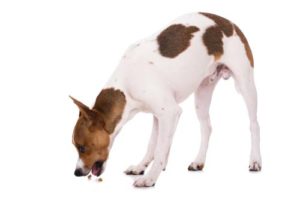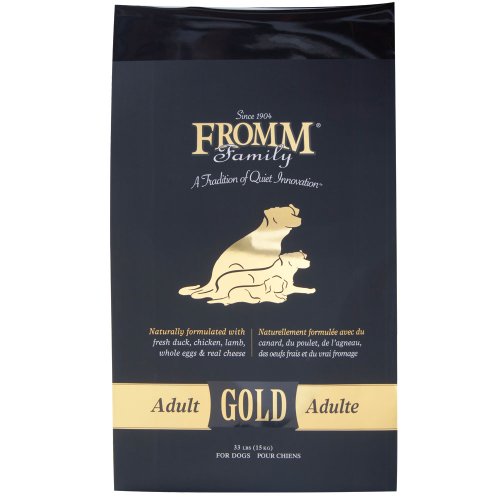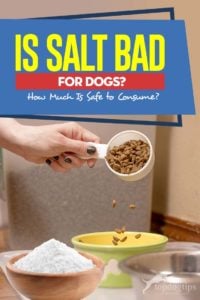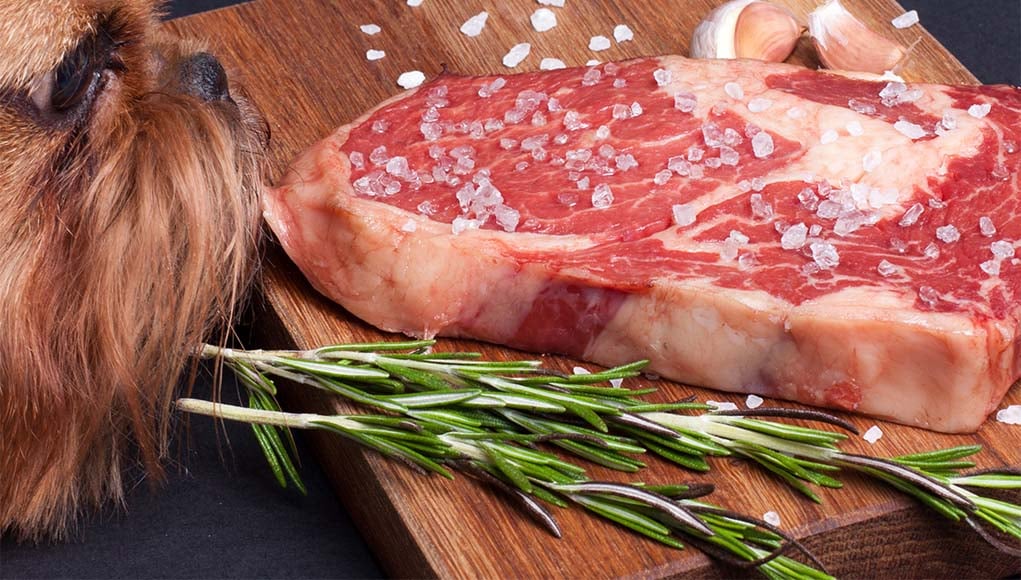There are so many human foods that are not recommended for dogs, and processed foods that we're tempted to share with our pets are often high in salt. But is salt bad for dogs and can it harm them? The simple answer is NO – salt is not bad to dogs; it's an essential mineral in their diet (just like it is for us and most mammals). However, like with most things, it has to be given in moderation.
Salt is crucial in a dog's diet for proper cell function, organ function, signal transmission through the nerves, and fluid balance when ingested in healthy amounts.
Most dog foods will contain salt (sodium chloride). According to AAFCO (PDF source), all dry dog food brands should contain at least 0.3% sodium for growth and reproduction, and at least 0.08% sodium for adult maintenance. Most healthy dogs will actually consume regular pet foods that will be higher in salt content. However, dogs with blood pressure issues or heart disease might need a diet that's lower in salt.
Too much or too little salt could cause a dog’s body harm in more ways than one, so let's take a look at everything owners should know about feeding salt for dogs.
Excessive Salt Intake in Dogs
If a dog gets into and consumes foods that have a high salt content, they may suffer from dehydration first, even if it is a one time occurrence. This can be quickly solved with allowing and encouraging the dog to consume plenty of water.
Salt toxicity (also known as salt poisoning, water deprivation–sodium ion intoxication, or simply hypernatremia) is a possible next stage if a dog is not able to re-hydrate properly and quickly after consuming too much sodium at once, or if they were exposed to a high amount of salt for an extended period of time.
Oral lethal dose of salt in dogs is:
approx. 2 g/lb (4 g/kg)
While salt toxicity in dogs is rare simply because it's difficult to overfeed a dog on sodium, pet owners must still know the symptoms of salt poisoning in dogs for the emergency situations when their pups may ingest a large amount of salt so that you can help them.
Symptoms of Salt Poisoning in Dogs
Salt poisoning can have mild to severe effects on a dog. The symptoms of salt poisoning in dogs can be seen almost instantly (often starting with vomiting) or over the course of several days; this depends on the quantity of salt they have eaten.
Most common symptoms of salt poisoning in dogs to look for:
 Excessive thirst due to dehydration
Excessive thirst due to dehydration- Tiredness or weakness
- Unexplained scratching
- Disorientation
- Decrease in appetite or refusal to eat
- Vomiting
- Diarrhea
- Limping
- Seizures or coma
What to Do If Your Dog Consumed Salt/Sodium…
If you believe that your dog has consumed too much salt and/or is exhibiting mild symptoms of salt toxicity, there are a few things that you can do to help them.
1. First, remove your dog's access to any foods or liquids with sodium.
2. Second, make sure that they have access to plenty of fresh, clean water. This will be most helpful for dogs who aren't experiencing any symptoms yet, or only experiencing mild symptoms of salt poisoning.
3. Observe the dog closely for several hours. Make sure they consume water. If need be, use these techniques to encourage the dog to consume water.
4. Finally, if you know the pet has consumed too much sodium but isn't showing any serious clinical signs of salt toxicity, you can use emetics or other methods to make him throw up.
If your dog is exhibiting more severe signs of salt poisoning such as seizures, then you should take them to the veterinarian immediately before their symptoms get any worse.
For cases of severe hypernatremia, the survival prognosis is approximately 50%. When the sodium levels raise to a certain extent, even aggressive therapy at a vet's clinic may not save the animal, such as in this case of Airedale terrier.
How Much Salt is Too Much for Dogs?
Even though dogs do need some salt in their diet, obviously cannot handle as much salt as humans. The American Heart Association recommends that people get no more than 2,300 mg of sodium per day (heart.org), whereas a dog’s daily recommended dose is between 0.25g/100g and 1.5g/100g.
The large variance between what is recommended for humans versus what is recommended for dogs is one of the main reasons why dogs should not eat the many different human foods, especially table scraps, fast food or anything processed.
Human Foods High in Sodium
It is important to be careful not to feed your dog human foods that may be high in salt, no matter how sad those puppy eyes staring up at you look. The following is a list of some of the most common human foods that are high in salt and should not be fed to dogs:
- Processed meats such as sausages and hot dogs
- Snack foods such as crackers, chips and popcorn
- Fast food, including french fries and hamburgers
- Many brands of cheese
- Pizza
- Many brands of canned vegetables
- Most highly processed foods
Salt in Dog Food
As previously mentioned, most packaged dog foods that you can purchase already contain a proper amount of sodium. It is suggested to double check the nutrition label on the bag of dog food to ensure that the food is not inadvertently too high in sodium for your dog. However, if your dog is generally healthy, there is nearly zero risk with U.S. bought foods and studies suggest for pet owners to simply not worry about sodium in kibble/wet food.
Salt is a natural preservative that helps your dog’s food stay fresh as well as providing your canine with one of the most important minerals on earth. Dog food aside, it's also vital to know how much salt is in any dog treats that you feed to your pup, because this will count on top of anything that's already part of a regular diet.
If the dog food you use is already borderline high in salt content and you choose a brand of dog treats that's slightly higher in sodium, there's obviously a risk of your dog consuming too much salt. When looking for the best dog treats, it's smart to pick the ones with least amount of preservatives (like salt) and minimum ingredients.
 Finally, keep in mind that salt in foods isn't the only culprit for owners to watch out for. There have been reports of dogs developing hypernatremia/salt toxicity simply from running around and swimming in or by the ocean (which contains 3.5% sodium) and then not having any access to fresh water.
Finally, keep in mind that salt in foods isn't the only culprit for owners to watch out for. There have been reports of dogs developing hypernatremia/salt toxicity simply from running around and swimming in or by the ocean (which contains 3.5% sodium) and then not having any access to fresh water.
Best Low Sodium Dog Foods
While there are some benefits to having salt in dog food, it may be necessary for some dogs to be placed on a special, low sodium diet. Conditions that may warrant a low sodium diet include heart disease, liver disease, and kidney disease.
Some of the best low sodium dog food brands currently available are these:
| Preview | Product | Rating | |
|---|---|---|---|

|
Earthborn Holistic Weight Control Grain-Free Dry... | 224 Reviews | Check Price |

|
Wellness Complete Health Dry Dog Food with Grains,... | 3,853 Reviews | Check Price |

|
Fromm Family Foods 727520 Gold Nutritionals Adult... | 542 Reviews | Check Price |
Salt Deficiency
Salt deficiency in dogs is on the completely opposite side of the spectrum. In some cases, dogs may become salt deficient, which is why it's important you do not remove all salt from your pet's diet. Just as salt is important for humans, it is also important for dogs.
If a dog becomes salt deficient, their bodies could start to shut down. Salt is a crucial mineral and helps dog’s organs operate. When an animal is salt deficient for too long, their organs slowly begin to stop functioning properly.
To ensure that your pooch does not become salt deficient, make sure that they maintain a well balanced diet. Most commercial dog food brands that are available for purchase are formulated with the proper amount of salt. If you're feeding your dog a homemade diet, you'll have to do your own math on how much sodium your pup is consuming.
In Summary
When given in moderation, salt for dogs is completely safe for consume. Not only that, but this mineral is crucial in their diet for their body to function properly.
An abnormally high amount of salt in a dogs diet can cause a variety of problems from dehydration to salt toxicity. A dog can may develop increased levels of sodium in their system from either a one time ingestion of too much salt, or due to constantly eating high amounts over a period of time.
 Symptoms of salt poisoning in dogs range from excessive thirst for mild cases to seizures and coma in severe cases. To help a dog with salt poisoning, provide access to fresh clean drinking water.
Symptoms of salt poisoning in dogs range from excessive thirst for mild cases to seizures and coma in severe cases. To help a dog with salt poisoning, provide access to fresh clean drinking water.
On the other hand, dogs can also experience salt deficiency when their diet lacks in sodium. Most dog food brands are formulated with the proper amount of salt needed for a dog to function properly. Low sodium diets may be suggested for dogs with heart, liver, or kidney disease. To keep your dog healthy, do not remove all salt from their diet, but do not feed them human foods known to be high in salt either.
READ NEXT: 15 Best Sensitive Stomach Dog Foods for Upset Stomachs
Disclosure: We may earn affiliate commissions at no cost to you from the links on this page. This did not affect our assessment of products. Read more here and find full disclosure here.













